Class Differences in Sumerian Civilization vs. Modern Society
VerifiedAdded on 2023/04/21
|9
|2710
|415
Essay
AI Summary
This essay provides a comparative analysis of class distinctions in Sumerian and modern civilizations. It begins by outlining the socio-political systems and the concept of class distinction, setting the stage for a detailed comparison. The essay describes the four main classes in Sumerian society: nobles, clients, commoners, and slaves, detailing their roles and social standings. It then contrasts this with the modern class structure, primarily divided into working and ruling classes. The differences stem from the presence of slaves and priests in Sumerian society, which are absent in the modern context. Similarities are drawn in the power dynamics where upper classes control other segments. The essay also explores the influence of religion and money in each civilization. It highlights the limited social mobility in Sumerian society compared to the modern era, where education and wealth offer opportunities for advancement. Finally, the essay examines how changes in social infrastructure and the division of labor have influenced class structures, concluding with a reflection on diversity and social stratification in both civilizations.
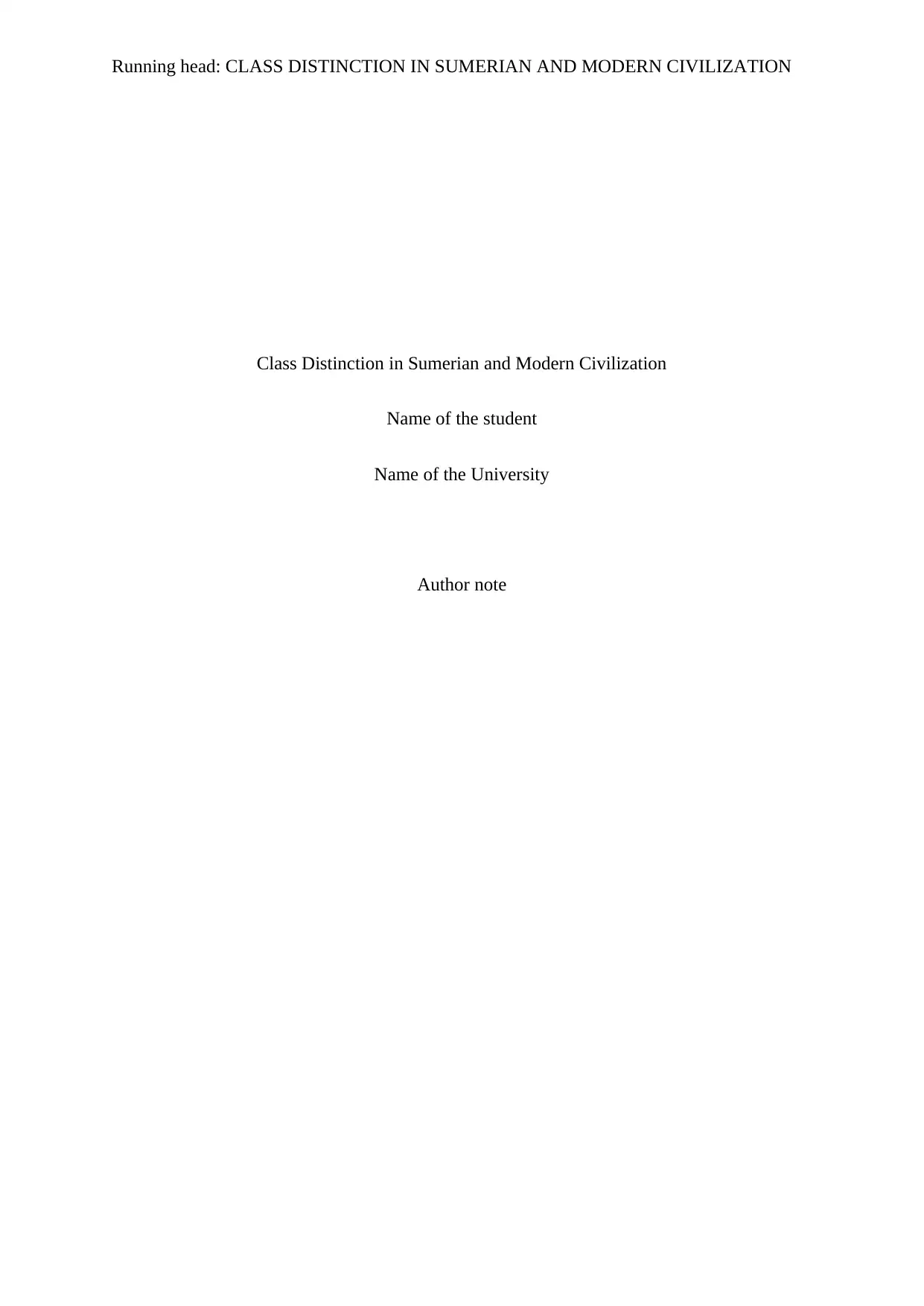
Running head: CLASS DISTINCTION IN SUMERIAN AND MODERN CIVILIZATION
Class Distinction in Sumerian and Modern Civilization
Name of the student
Name of the University
Author note
Class Distinction in Sumerian and Modern Civilization
Name of the student
Name of the University
Author note
Paraphrase This Document
Need a fresh take? Get an instant paraphrase of this document with our AI Paraphraser
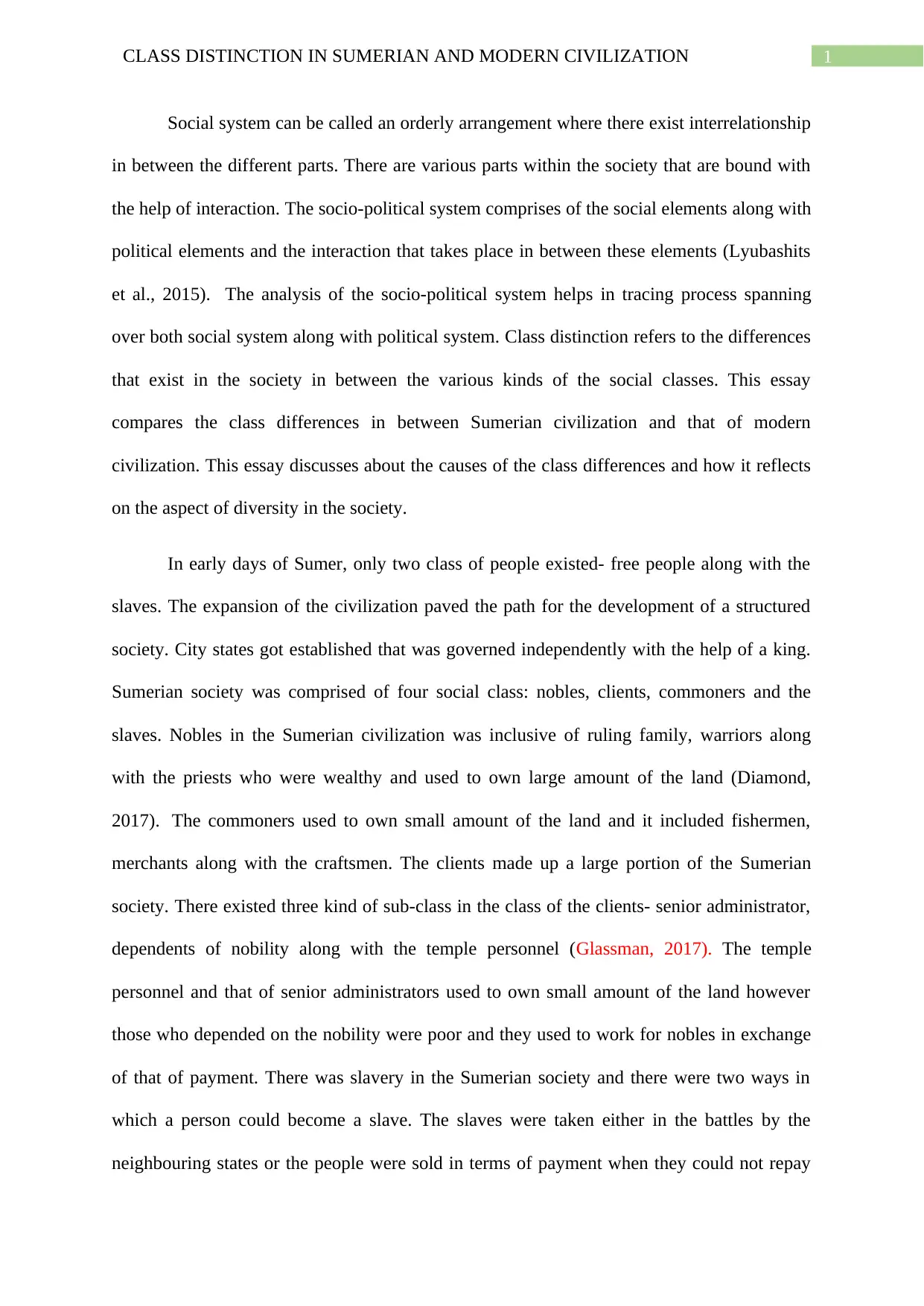
1CLASS DISTINCTION IN SUMERIAN AND MODERN CIVILIZATION
Social system can be called an orderly arrangement where there exist interrelationship
in between the different parts. There are various parts within the society that are bound with
the help of interaction. The socio-political system comprises of the social elements along with
political elements and the interaction that takes place in between these elements (Lyubashits
et al., 2015). The analysis of the socio-political system helps in tracing process spanning
over both social system along with political system. Class distinction refers to the differences
that exist in the society in between the various kinds of the social classes. This essay
compares the class differences in between Sumerian civilization and that of modern
civilization. This essay discusses about the causes of the class differences and how it reflects
on the aspect of diversity in the society.
In early days of Sumer, only two class of people existed- free people along with the
slaves. The expansion of the civilization paved the path for the development of a structured
society. City states got established that was governed independently with the help of a king.
Sumerian society was comprised of four social class: nobles, clients, commoners and the
slaves. Nobles in the Sumerian civilization was inclusive of ruling family, warriors along
with the priests who were wealthy and used to own large amount of the land (Diamond,
2017). The commoners used to own small amount of the land and it included fishermen,
merchants along with the craftsmen. The clients made up a large portion of the Sumerian
society. There existed three kind of sub-class in the class of the clients- senior administrator,
dependents of nobility along with the temple personnel (Glassman, 2017). The temple
personnel and that of senior administrators used to own small amount of the land however
those who depended on the nobility were poor and they used to work for nobles in exchange
of that of payment. There was slavery in the Sumerian society and there were two ways in
which a person could become a slave. The slaves were taken either in the battles by the
neighbouring states or the people were sold in terms of payment when they could not repay
Social system can be called an orderly arrangement where there exist interrelationship
in between the different parts. There are various parts within the society that are bound with
the help of interaction. The socio-political system comprises of the social elements along with
political elements and the interaction that takes place in between these elements (Lyubashits
et al., 2015). The analysis of the socio-political system helps in tracing process spanning
over both social system along with political system. Class distinction refers to the differences
that exist in the society in between the various kinds of the social classes. This essay
compares the class differences in between Sumerian civilization and that of modern
civilization. This essay discusses about the causes of the class differences and how it reflects
on the aspect of diversity in the society.
In early days of Sumer, only two class of people existed- free people along with the
slaves. The expansion of the civilization paved the path for the development of a structured
society. City states got established that was governed independently with the help of a king.
Sumerian society was comprised of four social class: nobles, clients, commoners and the
slaves. Nobles in the Sumerian civilization was inclusive of ruling family, warriors along
with the priests who were wealthy and used to own large amount of the land (Diamond,
2017). The commoners used to own small amount of the land and it included fishermen,
merchants along with the craftsmen. The clients made up a large portion of the Sumerian
society. There existed three kind of sub-class in the class of the clients- senior administrator,
dependents of nobility along with the temple personnel (Glassman, 2017). The temple
personnel and that of senior administrators used to own small amount of the land however
those who depended on the nobility were poor and they used to work for nobles in exchange
of that of payment. There was slavery in the Sumerian society and there were two ways in
which a person could become a slave. The slaves were taken either in the battles by the
neighbouring states or the people were sold in terms of payment when they could not repay
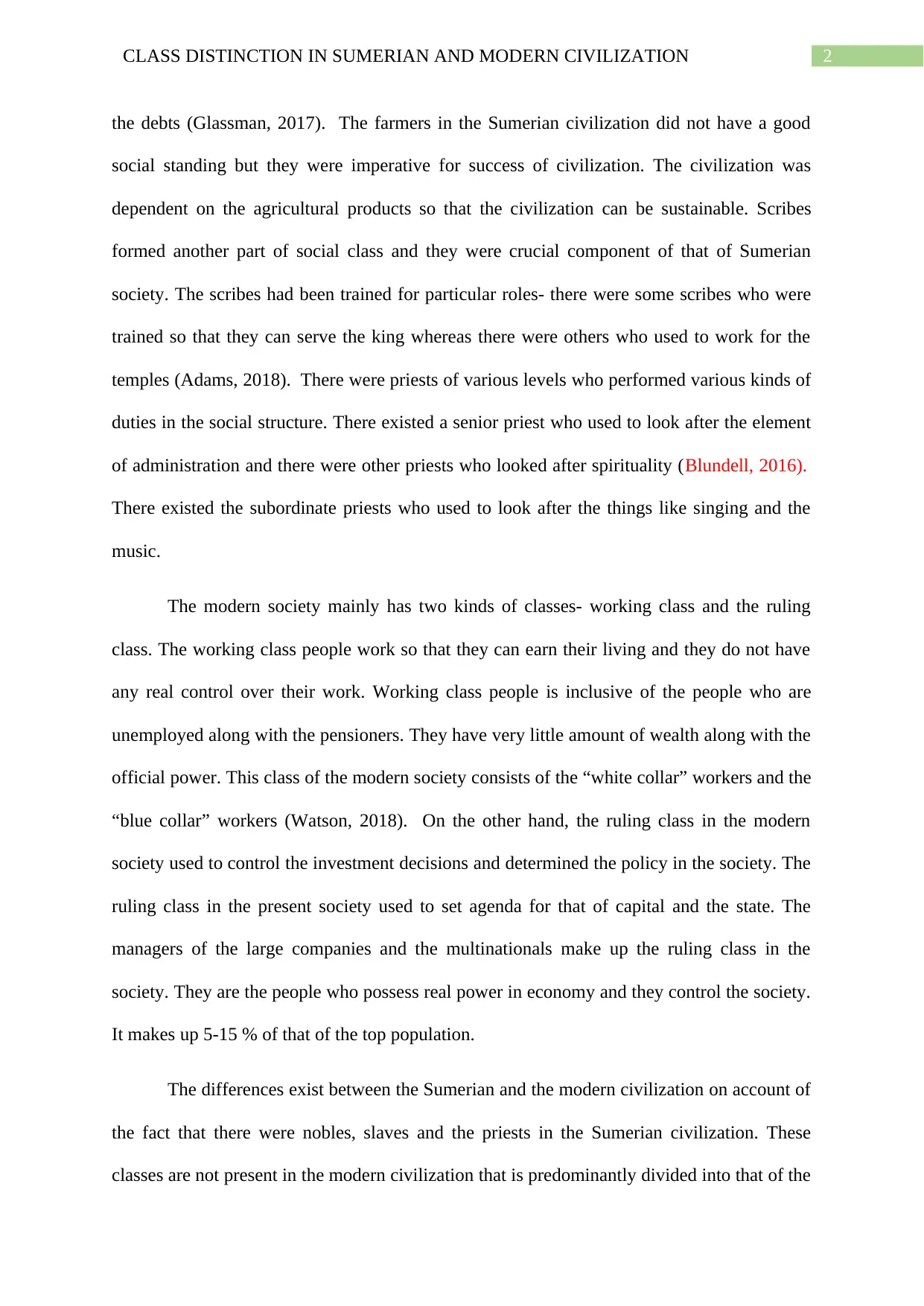
2CLASS DISTINCTION IN SUMERIAN AND MODERN CIVILIZATION
the debts (Glassman, 2017). The farmers in the Sumerian civilization did not have a good
social standing but they were imperative for success of civilization. The civilization was
dependent on the agricultural products so that the civilization can be sustainable. Scribes
formed another part of social class and they were crucial component of that of Sumerian
society. The scribes had been trained for particular roles- there were some scribes who were
trained so that they can serve the king whereas there were others who used to work for the
temples (Adams, 2018). There were priests of various levels who performed various kinds of
duties in the social structure. There existed a senior priest who used to look after the element
of administration and there were other priests who looked after spirituality (Blundell, 2016).
There existed the subordinate priests who used to look after the things like singing and the
music.
The modern society mainly has two kinds of classes- working class and the ruling
class. The working class people work so that they can earn their living and they do not have
any real control over their work. Working class people is inclusive of the people who are
unemployed along with the pensioners. They have very little amount of wealth along with the
official power. This class of the modern society consists of the “white collar” workers and the
“blue collar” workers (Watson, 2018). On the other hand, the ruling class in the modern
society used to control the investment decisions and determined the policy in the society. The
ruling class in the present society used to set agenda for that of capital and the state. The
managers of the large companies and the multinationals make up the ruling class in the
society. They are the people who possess real power in economy and they control the society.
It makes up 5-15 % of that of the top population.
The differences exist between the Sumerian and the modern civilization on account of
the fact that there were nobles, slaves and the priests in the Sumerian civilization. These
classes are not present in the modern civilization that is predominantly divided into that of the
the debts (Glassman, 2017). The farmers in the Sumerian civilization did not have a good
social standing but they were imperative for success of civilization. The civilization was
dependent on the agricultural products so that the civilization can be sustainable. Scribes
formed another part of social class and they were crucial component of that of Sumerian
society. The scribes had been trained for particular roles- there were some scribes who were
trained so that they can serve the king whereas there were others who used to work for the
temples (Adams, 2018). There were priests of various levels who performed various kinds of
duties in the social structure. There existed a senior priest who used to look after the element
of administration and there were other priests who looked after spirituality (Blundell, 2016).
There existed the subordinate priests who used to look after the things like singing and the
music.
The modern society mainly has two kinds of classes- working class and the ruling
class. The working class people work so that they can earn their living and they do not have
any real control over their work. Working class people is inclusive of the people who are
unemployed along with the pensioners. They have very little amount of wealth along with the
official power. This class of the modern society consists of the “white collar” workers and the
“blue collar” workers (Watson, 2018). On the other hand, the ruling class in the modern
society used to control the investment decisions and determined the policy in the society. The
ruling class in the present society used to set agenda for that of capital and the state. The
managers of the large companies and the multinationals make up the ruling class in the
society. They are the people who possess real power in economy and they control the society.
It makes up 5-15 % of that of the top population.
The differences exist between the Sumerian and the modern civilization on account of
the fact that there were nobles, slaves and the priests in the Sumerian civilization. These
classes are not present in the modern civilization that is predominantly divided into that of the
⊘ This is a preview!⊘
Do you want full access?
Subscribe today to unlock all pages.

Trusted by 1+ million students worldwide
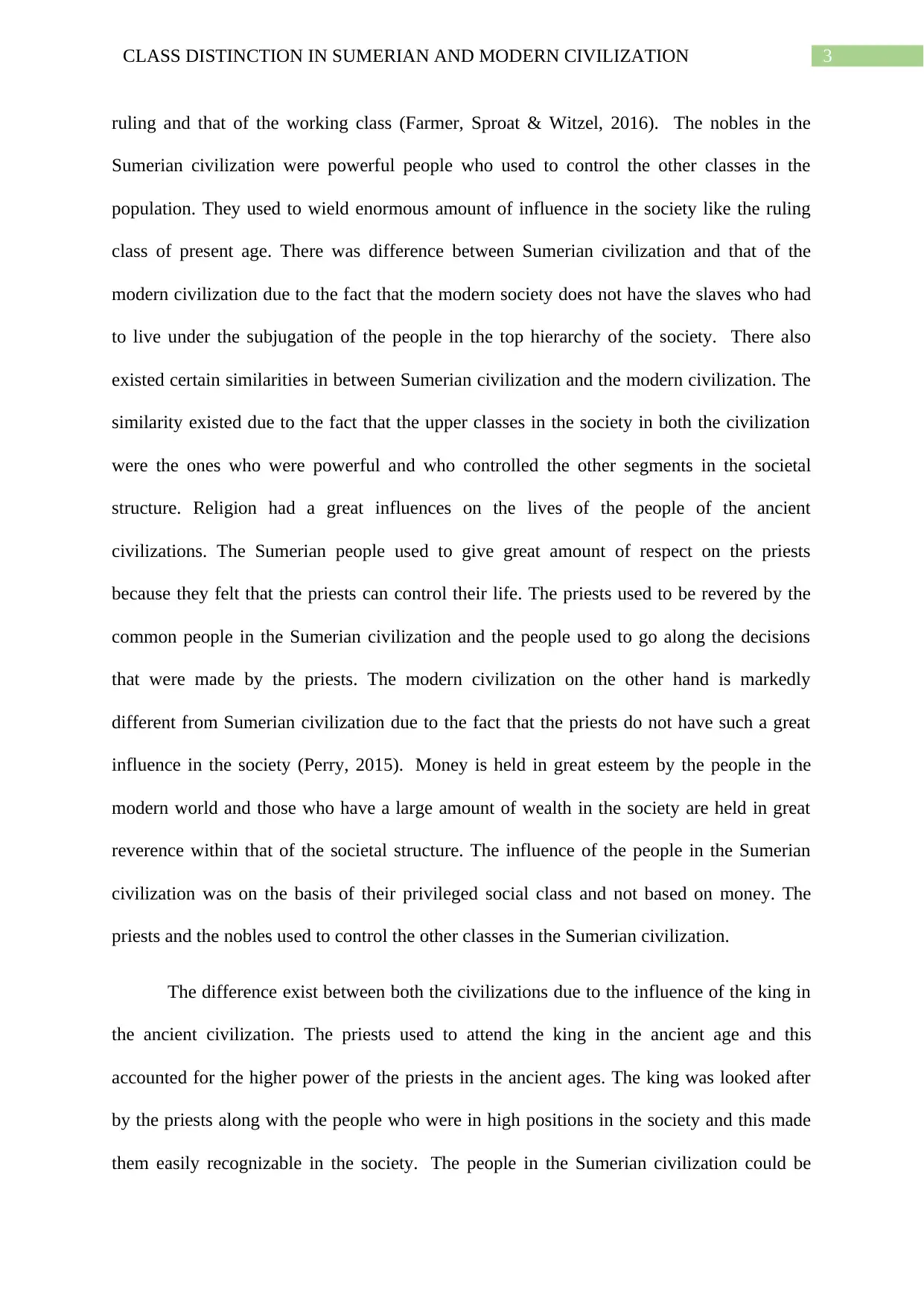
3CLASS DISTINCTION IN SUMERIAN AND MODERN CIVILIZATION
ruling and that of the working class (Farmer, Sproat & Witzel, 2016). The nobles in the
Sumerian civilization were powerful people who used to control the other classes in the
population. They used to wield enormous amount of influence in the society like the ruling
class of present age. There was difference between Sumerian civilization and that of the
modern civilization due to the fact that the modern society does not have the slaves who had
to live under the subjugation of the people in the top hierarchy of the society. There also
existed certain similarities in between Sumerian civilization and the modern civilization. The
similarity existed due to the fact that the upper classes in the society in both the civilization
were the ones who were powerful and who controlled the other segments in the societal
structure. Religion had a great influences on the lives of the people of the ancient
civilizations. The Sumerian people used to give great amount of respect on the priests
because they felt that the priests can control their life. The priests used to be revered by the
common people in the Sumerian civilization and the people used to go along the decisions
that were made by the priests. The modern civilization on the other hand is markedly
different from Sumerian civilization due to the fact that the priests do not have such a great
influence in the society (Perry, 2015). Money is held in great esteem by the people in the
modern world and those who have a large amount of wealth in the society are held in great
reverence within that of the societal structure. The influence of the people in the Sumerian
civilization was on the basis of their privileged social class and not based on money. The
priests and the nobles used to control the other classes in the Sumerian civilization.
The difference exist between both the civilizations due to the influence of the king in
the ancient civilization. The priests used to attend the king in the ancient age and this
accounted for the higher power of the priests in the ancient ages. The king was looked after
by the priests along with the people who were in high positions in the society and this made
them easily recognizable in the society. The people in the Sumerian civilization could be
ruling and that of the working class (Farmer, Sproat & Witzel, 2016). The nobles in the
Sumerian civilization were powerful people who used to control the other classes in the
population. They used to wield enormous amount of influence in the society like the ruling
class of present age. There was difference between Sumerian civilization and that of the
modern civilization due to the fact that the modern society does not have the slaves who had
to live under the subjugation of the people in the top hierarchy of the society. There also
existed certain similarities in between Sumerian civilization and the modern civilization. The
similarity existed due to the fact that the upper classes in the society in both the civilization
were the ones who were powerful and who controlled the other segments in the societal
structure. Religion had a great influences on the lives of the people of the ancient
civilizations. The Sumerian people used to give great amount of respect on the priests
because they felt that the priests can control their life. The priests used to be revered by the
common people in the Sumerian civilization and the people used to go along the decisions
that were made by the priests. The modern civilization on the other hand is markedly
different from Sumerian civilization due to the fact that the priests do not have such a great
influence in the society (Perry, 2015). Money is held in great esteem by the people in the
modern world and those who have a large amount of wealth in the society are held in great
reverence within that of the societal structure. The influence of the people in the Sumerian
civilization was on the basis of their privileged social class and not based on money. The
priests and the nobles used to control the other classes in the Sumerian civilization.
The difference exist between both the civilizations due to the influence of the king in
the ancient civilization. The priests used to attend the king in the ancient age and this
accounted for the higher power of the priests in the ancient ages. The king was looked after
by the priests along with the people who were in high positions in the society and this made
them easily recognizable in the society. The people in the Sumerian civilization could be
Paraphrase This Document
Need a fresh take? Get an instant paraphrase of this document with our AI Paraphraser
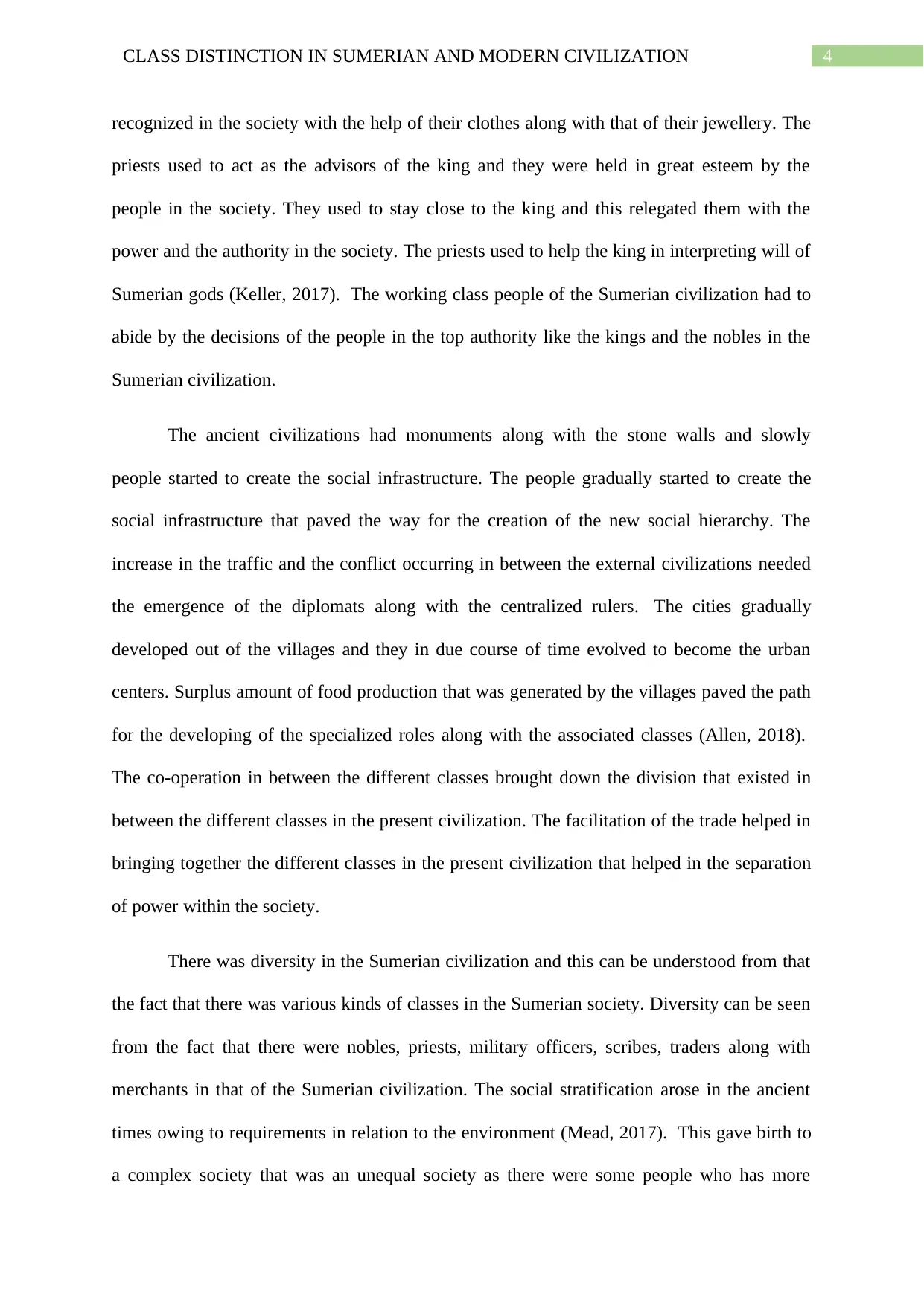
4CLASS DISTINCTION IN SUMERIAN AND MODERN CIVILIZATION
recognized in the society with the help of their clothes along with that of their jewellery. The
priests used to act as the advisors of the king and they were held in great esteem by the
people in the society. They used to stay close to the king and this relegated them with the
power and the authority in the society. The priests used to help the king in interpreting will of
Sumerian gods (Keller, 2017). The working class people of the Sumerian civilization had to
abide by the decisions of the people in the top authority like the kings and the nobles in the
Sumerian civilization.
The ancient civilizations had monuments along with the stone walls and slowly
people started to create the social infrastructure. The people gradually started to create the
social infrastructure that paved the way for the creation of the new social hierarchy. The
increase in the traffic and the conflict occurring in between the external civilizations needed
the emergence of the diplomats along with the centralized rulers. The cities gradually
developed out of the villages and they in due course of time evolved to become the urban
centers. Surplus amount of food production that was generated by the villages paved the path
for the developing of the specialized roles along with the associated classes (Allen, 2018).
The co-operation in between the different classes brought down the division that existed in
between the different classes in the present civilization. The facilitation of the trade helped in
bringing together the different classes in the present civilization that helped in the separation
of power within the society.
There was diversity in the Sumerian civilization and this can be understood from that
the fact that there was various kinds of classes in the Sumerian society. Diversity can be seen
from the fact that there were nobles, priests, military officers, scribes, traders along with
merchants in that of the Sumerian civilization. The social stratification arose in the ancient
times owing to requirements in relation to the environment (Mead, 2017). This gave birth to
a complex society that was an unequal society as there were some people who has more
recognized in the society with the help of their clothes along with that of their jewellery. The
priests used to act as the advisors of the king and they were held in great esteem by the
people in the society. They used to stay close to the king and this relegated them with the
power and the authority in the society. The priests used to help the king in interpreting will of
Sumerian gods (Keller, 2017). The working class people of the Sumerian civilization had to
abide by the decisions of the people in the top authority like the kings and the nobles in the
Sumerian civilization.
The ancient civilizations had monuments along with the stone walls and slowly
people started to create the social infrastructure. The people gradually started to create the
social infrastructure that paved the way for the creation of the new social hierarchy. The
increase in the traffic and the conflict occurring in between the external civilizations needed
the emergence of the diplomats along with the centralized rulers. The cities gradually
developed out of the villages and they in due course of time evolved to become the urban
centers. Surplus amount of food production that was generated by the villages paved the path
for the developing of the specialized roles along with the associated classes (Allen, 2018).
The co-operation in between the different classes brought down the division that existed in
between the different classes in the present civilization. The facilitation of the trade helped in
bringing together the different classes in the present civilization that helped in the separation
of power within the society.
There was diversity in the Sumerian civilization and this can be understood from that
the fact that there was various kinds of classes in the Sumerian society. Diversity can be seen
from the fact that there were nobles, priests, military officers, scribes, traders along with
merchants in that of the Sumerian civilization. The social stratification arose in the ancient
times owing to requirements in relation to the environment (Mead, 2017). This gave birth to
a complex society that was an unequal society as there were some people who has more
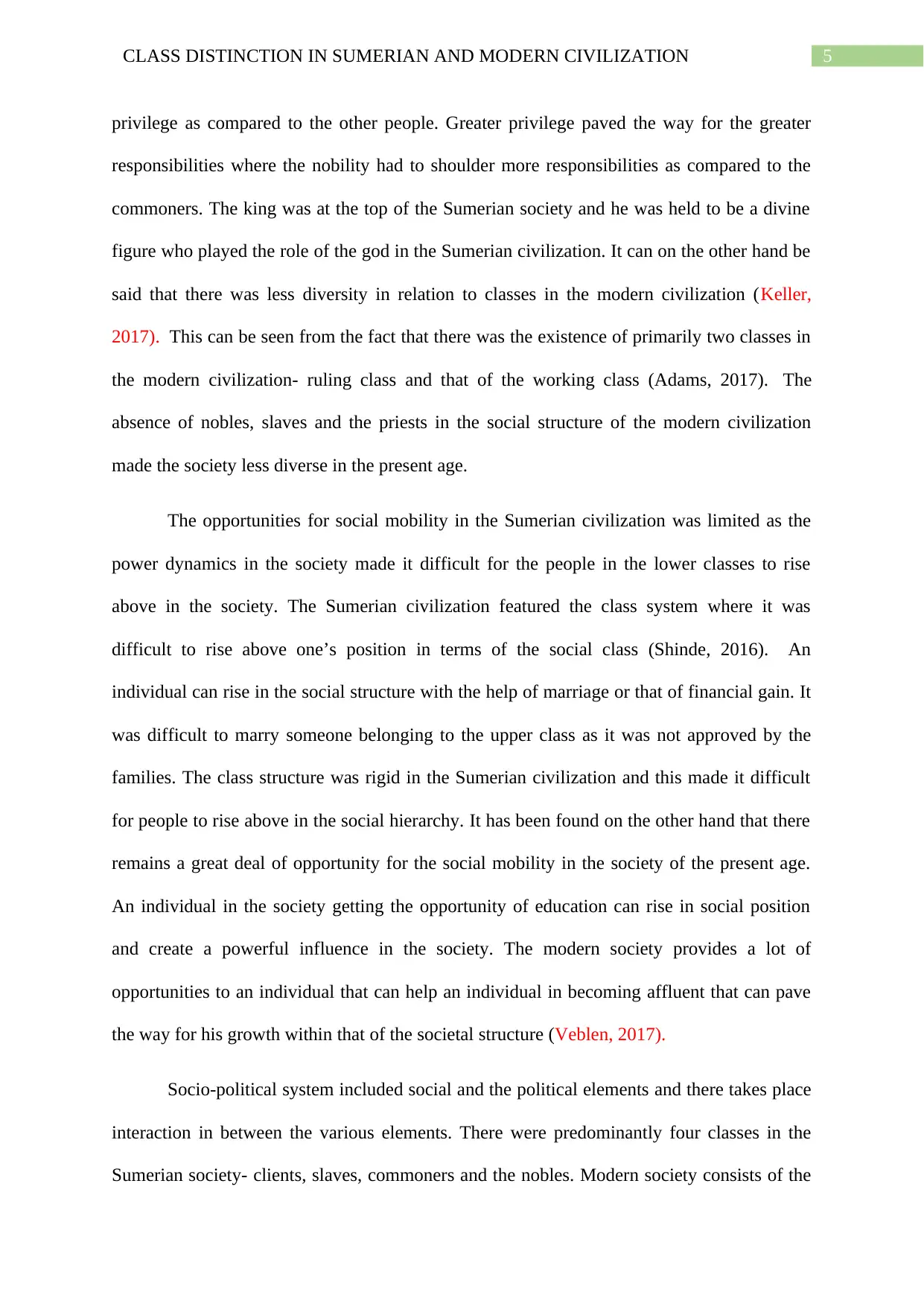
5CLASS DISTINCTION IN SUMERIAN AND MODERN CIVILIZATION
privilege as compared to the other people. Greater privilege paved the way for the greater
responsibilities where the nobility had to shoulder more responsibilities as compared to the
commoners. The king was at the top of the Sumerian society and he was held to be a divine
figure who played the role of the god in the Sumerian civilization. It can on the other hand be
said that there was less diversity in relation to classes in the modern civilization (Keller,
2017). This can be seen from the fact that there was the existence of primarily two classes in
the modern civilization- ruling class and that of the working class (Adams, 2017). The
absence of nobles, slaves and the priests in the social structure of the modern civilization
made the society less diverse in the present age.
The opportunities for social mobility in the Sumerian civilization was limited as the
power dynamics in the society made it difficult for the people in the lower classes to rise
above in the society. The Sumerian civilization featured the class system where it was
difficult to rise above one’s position in terms of the social class (Shinde, 2016). An
individual can rise in the social structure with the help of marriage or that of financial gain. It
was difficult to marry someone belonging to the upper class as it was not approved by the
families. The class structure was rigid in the Sumerian civilization and this made it difficult
for people to rise above in the social hierarchy. It has been found on the other hand that there
remains a great deal of opportunity for the social mobility in the society of the present age.
An individual in the society getting the opportunity of education can rise in social position
and create a powerful influence in the society. The modern society provides a lot of
opportunities to an individual that can help an individual in becoming affluent that can pave
the way for his growth within that of the societal structure (Veblen, 2017).
Socio-political system included social and the political elements and there takes place
interaction in between the various elements. There were predominantly four classes in the
Sumerian society- clients, slaves, commoners and the nobles. Modern society consists of the
privilege as compared to the other people. Greater privilege paved the way for the greater
responsibilities where the nobility had to shoulder more responsibilities as compared to the
commoners. The king was at the top of the Sumerian society and he was held to be a divine
figure who played the role of the god in the Sumerian civilization. It can on the other hand be
said that there was less diversity in relation to classes in the modern civilization (Keller,
2017). This can be seen from the fact that there was the existence of primarily two classes in
the modern civilization- ruling class and that of the working class (Adams, 2017). The
absence of nobles, slaves and the priests in the social structure of the modern civilization
made the society less diverse in the present age.
The opportunities for social mobility in the Sumerian civilization was limited as the
power dynamics in the society made it difficult for the people in the lower classes to rise
above in the society. The Sumerian civilization featured the class system where it was
difficult to rise above one’s position in terms of the social class (Shinde, 2016). An
individual can rise in the social structure with the help of marriage or that of financial gain. It
was difficult to marry someone belonging to the upper class as it was not approved by the
families. The class structure was rigid in the Sumerian civilization and this made it difficult
for people to rise above in the social hierarchy. It has been found on the other hand that there
remains a great deal of opportunity for the social mobility in the society of the present age.
An individual in the society getting the opportunity of education can rise in social position
and create a powerful influence in the society. The modern society provides a lot of
opportunities to an individual that can help an individual in becoming affluent that can pave
the way for his growth within that of the societal structure (Veblen, 2017).
Socio-political system included social and the political elements and there takes place
interaction in between the various elements. There were predominantly four classes in the
Sumerian society- clients, slaves, commoners and the nobles. Modern society consists of the
⊘ This is a preview!⊘
Do you want full access?
Subscribe today to unlock all pages.

Trusted by 1+ million students worldwide
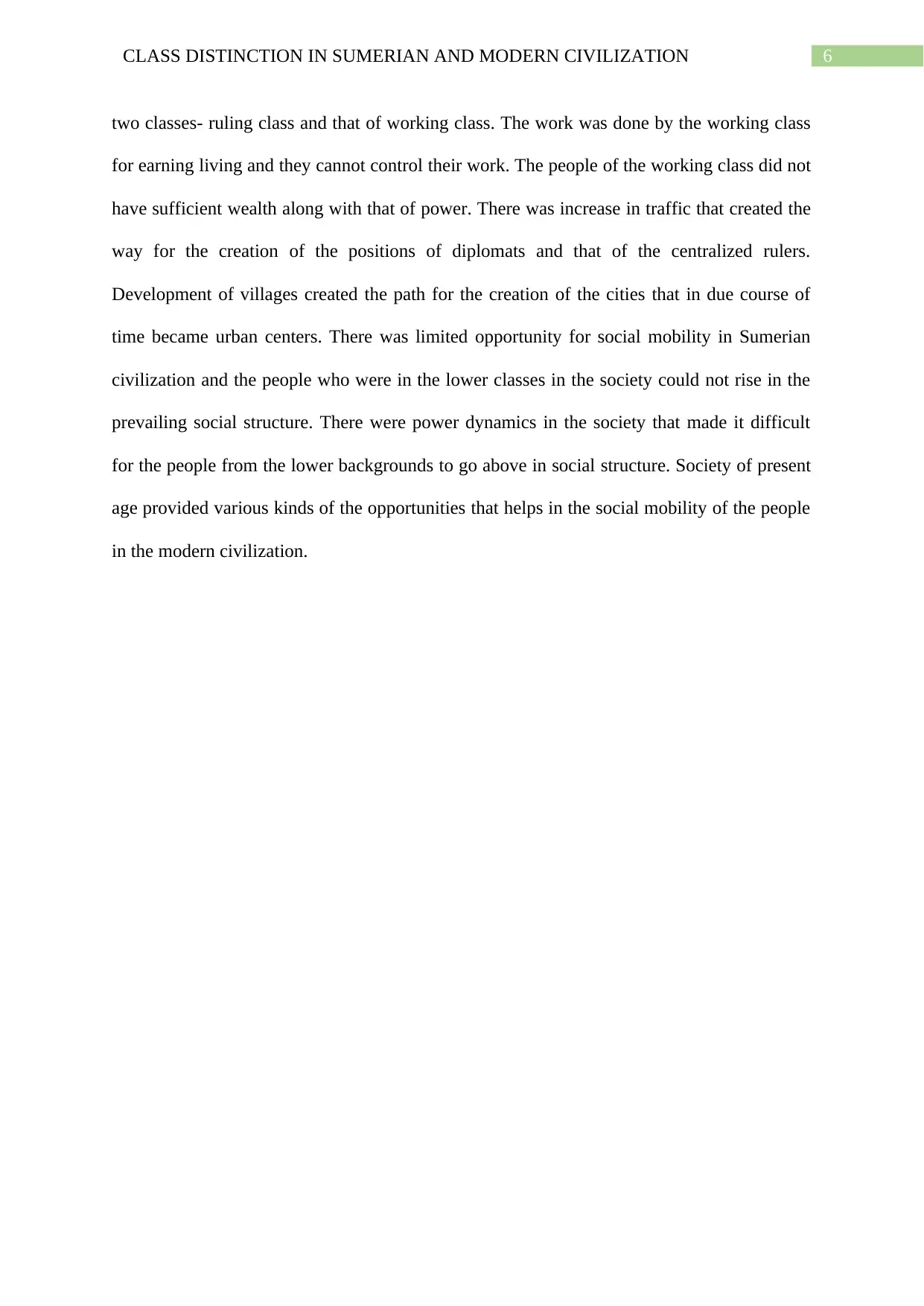
6CLASS DISTINCTION IN SUMERIAN AND MODERN CIVILIZATION
two classes- ruling class and that of working class. The work was done by the working class
for earning living and they cannot control their work. The people of the working class did not
have sufficient wealth along with that of power. There was increase in traffic that created the
way for the creation of the positions of diplomats and that of the centralized rulers.
Development of villages created the path for the creation of the cities that in due course of
time became urban centers. There was limited opportunity for social mobility in Sumerian
civilization and the people who were in the lower classes in the society could not rise in the
prevailing social structure. There were power dynamics in the society that made it difficult
for the people from the lower backgrounds to go above in social structure. Society of present
age provided various kinds of the opportunities that helps in the social mobility of the people
in the modern civilization.
two classes- ruling class and that of working class. The work was done by the working class
for earning living and they cannot control their work. The people of the working class did not
have sufficient wealth along with that of power. There was increase in traffic that created the
way for the creation of the positions of diplomats and that of the centralized rulers.
Development of villages created the path for the creation of the cities that in due course of
time became urban centers. There was limited opportunity for social mobility in Sumerian
civilization and the people who were in the lower classes in the society could not rise in the
prevailing social structure. There were power dynamics in the society that made it difficult
for the people from the lower backgrounds to go above in social structure. Society of present
age provided various kinds of the opportunities that helps in the social mobility of the people
in the modern civilization.
Paraphrase This Document
Need a fresh take? Get an instant paraphrase of this document with our AI Paraphraser
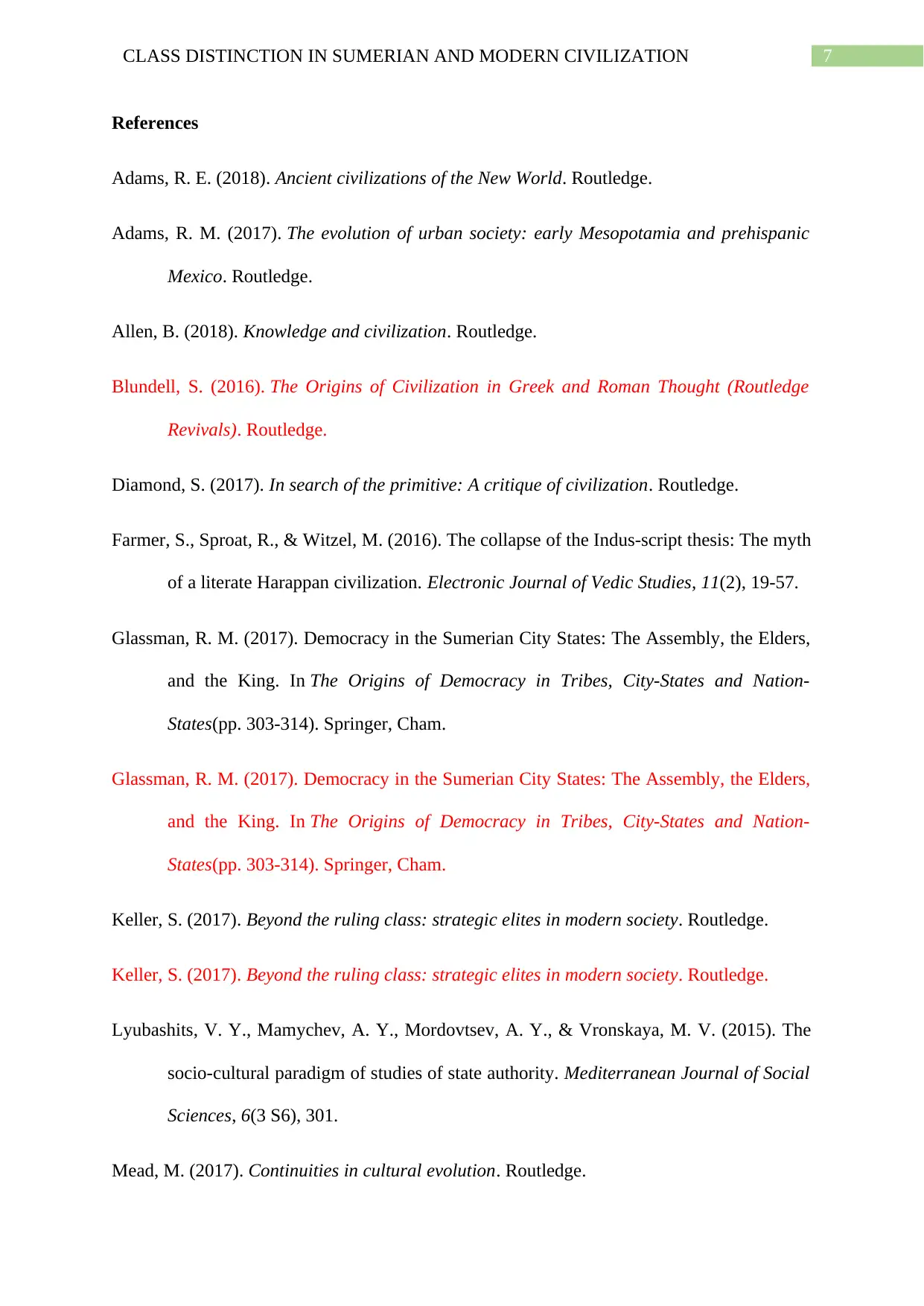
7CLASS DISTINCTION IN SUMERIAN AND MODERN CIVILIZATION
References
Adams, R. E. (2018). Ancient civilizations of the New World. Routledge.
Adams, R. M. (2017). The evolution of urban society: early Mesopotamia and prehispanic
Mexico. Routledge.
Allen, B. (2018). Knowledge and civilization. Routledge.
Blundell, S. (2016). The Origins of Civilization in Greek and Roman Thought (Routledge
Revivals). Routledge.
Diamond, S. (2017). In search of the primitive: A critique of civilization. Routledge.
Farmer, S., Sproat, R., & Witzel, M. (2016). The collapse of the Indus-script thesis: The myth
of a literate Harappan civilization. Electronic Journal of Vedic Studies, 11(2), 19-57.
Glassman, R. M. (2017). Democracy in the Sumerian City States: The Assembly, the Elders,
and the King. In The Origins of Democracy in Tribes, City-States and Nation-
States(pp. 303-314). Springer, Cham.
Glassman, R. M. (2017). Democracy in the Sumerian City States: The Assembly, the Elders,
and the King. In The Origins of Democracy in Tribes, City-States and Nation-
States(pp. 303-314). Springer, Cham.
Keller, S. (2017). Beyond the ruling class: strategic elites in modern society. Routledge.
Keller, S. (2017). Beyond the ruling class: strategic elites in modern society. Routledge.
Lyubashits, V. Y., Mamychev, A. Y., Mordovtsev, A. Y., & Vronskaya, M. V. (2015). The
socio-cultural paradigm of studies of state authority. Mediterranean Journal of Social
Sciences, 6(3 S6), 301.
Mead, M. (2017). Continuities in cultural evolution. Routledge.
References
Adams, R. E. (2018). Ancient civilizations of the New World. Routledge.
Adams, R. M. (2017). The evolution of urban society: early Mesopotamia and prehispanic
Mexico. Routledge.
Allen, B. (2018). Knowledge and civilization. Routledge.
Blundell, S. (2016). The Origins of Civilization in Greek and Roman Thought (Routledge
Revivals). Routledge.
Diamond, S. (2017). In search of the primitive: A critique of civilization. Routledge.
Farmer, S., Sproat, R., & Witzel, M. (2016). The collapse of the Indus-script thesis: The myth
of a literate Harappan civilization. Electronic Journal of Vedic Studies, 11(2), 19-57.
Glassman, R. M. (2017). Democracy in the Sumerian City States: The Assembly, the Elders,
and the King. In The Origins of Democracy in Tribes, City-States and Nation-
States(pp. 303-314). Springer, Cham.
Glassman, R. M. (2017). Democracy in the Sumerian City States: The Assembly, the Elders,
and the King. In The Origins of Democracy in Tribes, City-States and Nation-
States(pp. 303-314). Springer, Cham.
Keller, S. (2017). Beyond the ruling class: strategic elites in modern society. Routledge.
Keller, S. (2017). Beyond the ruling class: strategic elites in modern society. Routledge.
Lyubashits, V. Y., Mamychev, A. Y., Mordovtsev, A. Y., & Vronskaya, M. V. (2015). The
socio-cultural paradigm of studies of state authority. Mediterranean Journal of Social
Sciences, 6(3 S6), 301.
Mead, M. (2017). Continuities in cultural evolution. Routledge.
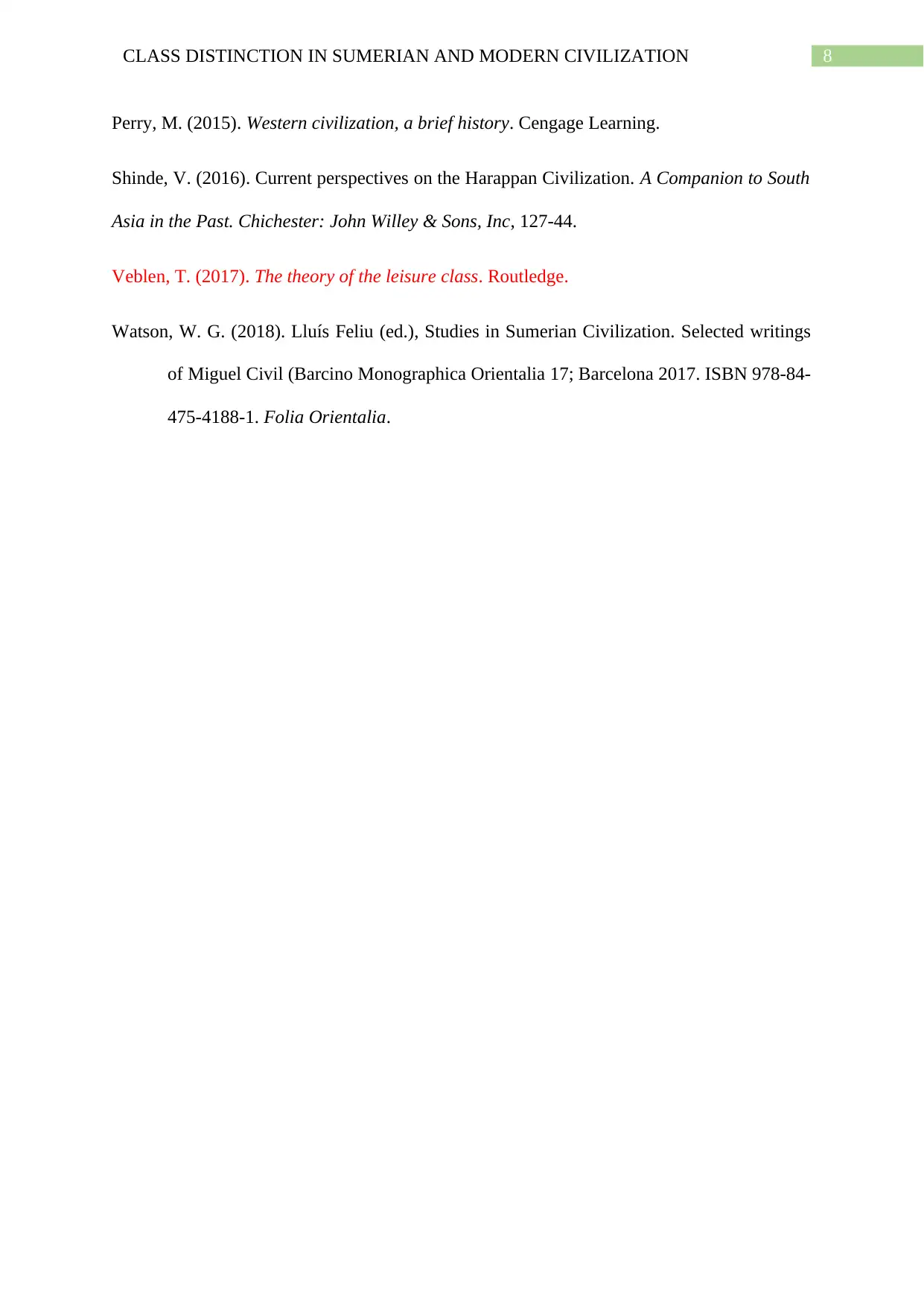
8CLASS DISTINCTION IN SUMERIAN AND MODERN CIVILIZATION
Perry, M. (2015). Western civilization, a brief history. Cengage Learning.
Shinde, V. (2016). Current perspectives on the Harappan Civilization. A Companion to South
Asia in the Past. Chichester: John Willey & Sons, Inc, 127-44.
Veblen, T. (2017). The theory of the leisure class. Routledge.
Watson, W. G. (2018). Lluís Feliu (ed.), Studies in Sumerian Civilization. Selected writings
of Miguel Civil (Barcino Monographica Orientalia 17; Barcelona 2017. ISBN 978-84-
475-4188-1. Folia Orientalia.
Perry, M. (2015). Western civilization, a brief history. Cengage Learning.
Shinde, V. (2016). Current perspectives on the Harappan Civilization. A Companion to South
Asia in the Past. Chichester: John Willey & Sons, Inc, 127-44.
Veblen, T. (2017). The theory of the leisure class. Routledge.
Watson, W. G. (2018). Lluís Feliu (ed.), Studies in Sumerian Civilization. Selected writings
of Miguel Civil (Barcino Monographica Orientalia 17; Barcelona 2017. ISBN 978-84-
475-4188-1. Folia Orientalia.
⊘ This is a preview!⊘
Do you want full access?
Subscribe today to unlock all pages.

Trusted by 1+ million students worldwide
1 out of 9
Your All-in-One AI-Powered Toolkit for Academic Success.
+13062052269
info@desklib.com
Available 24*7 on WhatsApp / Email
![[object Object]](/_next/static/media/star-bottom.7253800d.svg)
Unlock your academic potential
Copyright © 2020–2025 A2Z Services. All Rights Reserved. Developed and managed by ZUCOL.